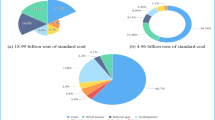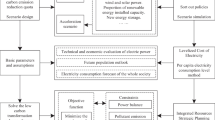Abstract
Low carbon transformation plays an important role in promoting the energy production and consumption revolution. Currently, the power sector of China still faces a series of challenges, such as the overcapacity of coal-fired power, the renewable energy consumption, the new constraints of carbon-emissions, and fragmented power planning. This study develops a multi-objective optimization model to predict the future trend of China power structure by 2035. The key factors such as network, power, load and storage are taken into account. Besides, the technical feasibility, economic rationality and social acceptable constraints are also fully considered. Through planning and optimization, the premise of low carbon transformation is to ensure the continuity of existing policies for removing inefficient assets, and the core is to develop and utilize non-fossil energy on a large scale. Specifically, the capacity of coal-fired power will be attained in the peak in 2025, and the factor will also transfer from main power supplier to main power and energy supplier. Before 2025, the clean replacement of incremental power installation will be completed. In 2035, 92% of new investment comes from non-fossil energy. The economy and competitiveness of wind power and PV (Photovoltaic) power generation are continuously increasing. By 2020, the coal-fired power and the wind power in eastern of China will be parity firstly. In 2025, the cost of PV and wind power will be the same. Furthermore, the evaluation dimension of modern power system with clean, low-carbon, safety and high efficiency are innovatively constructed, and the index system target of 2035 is quantitatively analyzed and prospected.
Similar content being viewed by others
References
Xi J., Remarks at the meeting of the Standing Committee of the Political Bureau of the 19th CPC Central Committee with Chinese and foreign journalists. http://www.xin-huanet.com/politics/19cpcnc/2017-10/25/c_129726443.htm, 2017(accessed on Oct 25, 2017).
China Electric Power News. Promoting green energy development in beautiful China. http://www.chinapower.com.cn/focus/20171107/95866.html, 2017 (accessed on Nov 07, 2017).
Rajendran D. R., Sundaram E. G., Jawahar P., Experimental studies on the thermal performance of a parabolic dish solar receiver with the heat transfer fluids SiC + water nano fluid and water. Journal of Thermal Science, 2017, 26(3): 263–272.
Gradziel S., Witkowski K., Influence of biomass co-combustion on heating surfaces thermal efficiency. Journal of Thermal Science, 2018, 27(05): 427–432.
Arnett E. B., Brown W. K., Erickson W. P., Fiedler J. K., Hamilton B. L., Henry T. H., Jain A., Johnson G. D., Kerns J., Koford R. R., Nicholson C. P., O’Connell T. J., Piorkowski M. D., Tankersley R. D., Patterns of bat fatalities at wind energy facilities in north America. Journal of Wildlife Management, 2011, 72(1): 61–78.
China Electric Power Planning and Design Institute, et al. China electric power technology economic development Report 2009‒2017.
Motly P., Lach J., Computational modelling of retrofitting a coal-fired boiler type OP-230 for predicting NO_X reduction. Journal of Thermal Science, 2018, 27(05): 433–439.
Wang Z., Strategic thinking on the development of coal-fired power in China in 2050. http://www.cec.org.cn/huanbao/zhuanjiaguandian/2013-08-02/106758.html, 2013 (accessed on Aug 02, 2013).
Wang Z., The carbon market will become a strong wind for the green development of electric power in China. http://www.cec.org.cn/yaowenkuaidi/2018-03-07/178367.html, 2018 (accessed on Mar 07, 2018).
Sara H., Chalet D., Cormerais M., Hetet J. F., Oil strategies benefits over different driving cycles using numerical simulation. Journal of Thermal Science, 2017, 26(4): 371–377.
NDRC. Enhanced actions on climate change: China’s intended nationally determined contributions. http://zys.ndrc.gov.cn/xwfb/201506/t20150630_710182.h tml, 2015 (accessed on Jun 30, 2015).
The State Council. Work plan to control greenhouse gas emissions during the 13th Five-Year Plan Period. http://www.gov.cn/zhengce/content/2016-11/04/content_5128619.htm, 2016 (accessd on Nov 04, 2016).
NDRC. The 13th FYP power development planning (2016-2020). http://www.ndrc.gov.cn/fzgggz/fzgh/ghwb/gjjgh/201706/t20170605_849994.html, 2017 (accessd on Jun 05, 2017).
Kafka R. J., Penders D. R., Bouchey S. H., Adibi M. M., System restoration plan development for a metropolitan electric system. Power Apparatus & Systems IEEE Transactions on. 1981, PAS-100(8): 3703‒3713.
Lei Q., Research on generation planning of China under the power low carbon transformation, North China Electric University, Beijing, 2017.
An Z., Jia L., Ding Y., Dang C. Li X., A review on Lithium-ion power battery thermal management technologies and thermal safety. Journal of Thermal Science, 2017, 26(05): 391–412.
European Environment Agency. Environment and climate policy evaluation. https://www.eea.europa.eu/publications/environment-and-climate-policy-evaluation, 2016 (accessd on Sep 05, 2016).
European Environment Agency. Reporting on Environmental Measures: Are We Being Effective? https://www.eea.europa.eu/publications/rem, 2011 (accessd on Nov 09, 2011).
Huang Q., Research review on quantitative analysis on governmental policies. Consume Guide, 2016, (2): 19‒19.
Kerr A., Serendipity is not a strategy: the impact of national climate programmes on greenhouse gas emissions. Area, 2007, 39(4): 418–430.
Mikael H., Andrew J., Tim R., Climate policy innovation: developing an evaluation perspective. Environmental Politics, 2014, 23(5): 884–905.
NDRC. Outline of the thirteenth year plan for national economy and social development in People’s Republic of China. http://www.xinhuanet.com/politics/2016lh/2016-03/17/c_1118366322_21.htm, 2016 (accessd on Mar 07, 2016).
Zhang N., Xing L., Lu G., Prospects for china’s electric power development in 2050. China Power, 2018, 40(3): 5–10.
China Chemical and Physical Power Sector Association. 2018 Applied Research Report for Energy Storage Sector. Beijing, 2018.
Ma J. J., Du G., Xie B. C., CO2 emission changes of China’s power generation system: Input-output subsystem analysis. Energy Policy, 2019, 124: 1–12.
Xian Y., Wang K., Shi X., Zhang C., Wei Y. M., Huang Z., Carbon emissions intensity reduction target for China’s power industry: An efficiency and productivity perspective. Journal of Cleaner Production, 2018, 197(1): 1022–1034.
Liu Q., Zheng X. Q., Zhao X. C., Chen Y., Lugovoy O., Carbon emission scenarios of China’s power sector: Impact of controlling measures and carbon pricing mechanism. Advances in Climate Change Research, 2018, 9(1): 27–33.
Dai P., Zou J., Tian J., Liu T., Zhou H., Comprehensive optimization of carbon emission reduction in China’s power industry. Automation of Power System, 2013, 37(14): 1–6.
Wright T., Factors affecting the cost of air plane. Journal of Aeronautical Science, 1936, 3(2): 122–128.
Zheng S., Sun Z., Theory of the carbon price formation mechanism of carbon trading pilot. Energy of China, 2017, 39(4): 9–14.
China carbon forum. 2018 China carbon pricing survey. http://www.chinacarbon.info/wp-content/uploads/2018/07/2018-China-Carbon-Pricing-Survey-v4-1.pdf.2018. (accessd on Jul 13, 2018).
CEC (China Electricity Council), 2012a, Annual Statistics of China Power Industry 2011.
CEC, 2012b. The Annual Development Report of Chinese Power Industry 2012. Market Press, Beijing: China.
CEC, 2013a. Annual Statistics of China Power Industry 2012.
CEC, 2013b. The Annual Development Report of Chinese Power Industry 2013. Market Press, Beijing: China.
CEC, 2014a. Annual Statistics of China Power Industry 2013.
CEC, 2014b. The Annual Development Report of Chinese Power Industry 2014. Market Press, Beijing: China.
CEC, 2015a. Annual Statistics of China Power Industry 2014.
CEC, 2015b. The Annual Development Report of Chinese Power Industry 2015. Market Press, Beijing: China.
CEC, 2016a. Annual Statistics of China Power Industry 2015.
CEC, 2016b. The Annual Development Report of Power Sector. Market Press, Beijing, China.
CEC, 2017a. Annual Statistics of China Power Industry 2016.
CEC, 2017b. The Annual Development Report of Power Sector. Market Press, Beijing, China.
CEC. Report on the analysis and forecast of national power supply and demand situation in the first three quarters of 2018. http://www.cec.org.cn/guihuayutongji/gongxufenxi/dianligongxufenxi/2018-11-01/186044.html, 2018 (accessd on Nov 01, 2018).
Acknowledgment
This work was supported by the National Key Research and Development Program of China under grant number 2017YFB0601803.
Author information
Authors and Affiliations
Corresponding authors
Rights and permissions
About this article
Cite this article
Wu, J., Tang, G., Wang, R. et al. Multi-Objective Optimization for China’s Power Carbon Emission Reduction by 2035. J. Therm. Sci. 28, 184–194 (2019). https://doi.org/10.1007/s11630-019-1108-6
Received:
Published:
Issue Date:
DOI: https://doi.org/10.1007/s11630-019-1108-6




